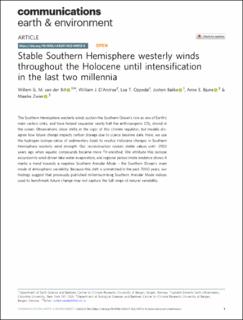| dc.contributor.author | van der Bilt, Willem Godert Maria | |
| dc.contributor.author | D’Andrea, William J. | |
| dc.contributor.author | Oppedal, Lea Toska | |
| dc.contributor.author | Bakke, Jostein | |
| dc.contributor.author | Bjune, Anne Elisabeth | |
| dc.contributor.author | Zwier, Maaike | |
| dc.date.accessioned | 2022-12-01T10:34:35Z | |
| dc.date.available | 2022-12-01T10:34:35Z | |
| dc.date.created | 2022-11-08T15:20:20Z | |
| dc.date.issued | 2022 | |
| dc.identifier.issn | 2662-4435 | |
| dc.identifier.uri | https://hdl.handle.net/11250/3035280 | |
| dc.description.abstract | The Southern Hemisphere westerly winds sustain the Southern Ocean’s role as one of Earth’s main carbon sinks, and have helped sequester nearly half the anthropogenic CO2 stored in the ocean. Observations show shifts in the vigor of this climate regulator, but models disagree how future change impacts carbon storage due to scarce baseline data. Here, we use the hydrogen isotope ratios of sedimentary lipids to resolve Holocene changes in Southern Hemisphere westerly wind strength. Our reconstruction reveals stable values until ~2150 years ago when aquatic compounds became more 2H-enriched. We attribute this isotope excursion to wind-driven lake water evaporation, and regional paleoclimate evidence shows it marks a trend towards a negative Southern Annular Mode – the Southern Ocean’s main mode of atmospheric variability. Because this shift is unmatched in the past 7000 years, our findings suggest that previously published millennium-long Southern Annular Mode indices used to benchmark future change may not capture the full range of natural variability. | en_US |
| dc.language.iso | eng | en_US |
| dc.publisher | Springer Nature | en_US |
| dc.rights | Navngivelse 4.0 Internasjonal | * |
| dc.rights.uri | http://creativecommons.org/licenses/by/4.0/deed.no | * |
| dc.title | Stable Southern Hemisphere westerly winds throughout the Holocene until intensification in the last two millennia | en_US |
| dc.type | Journal article | en_US |
| dc.type | Peer reviewed | en_US |
| dc.description.version | publishedVersion | en_US |
| dc.rights.holder | Copyright 2022 the authors | en_US |
| dc.source.articlenumber | 186 | en_US |
| cristin.ispublished | true | |
| cristin.fulltext | original | |
| cristin.qualitycode | 1 | |
| dc.identifier.doi | 10.1038/s43247-022-00512-8 | |
| dc.identifier.cristin | 2070756 | |
| dc.source.journal | Communications Earth & Environment | en_US |
| dc.identifier.citation | Communications Earth & Environment. 2022, 3, 186. | en_US |
| dc.source.volume | 3 | en_US |

